The Mount Vesuvius Eruption of March 1944
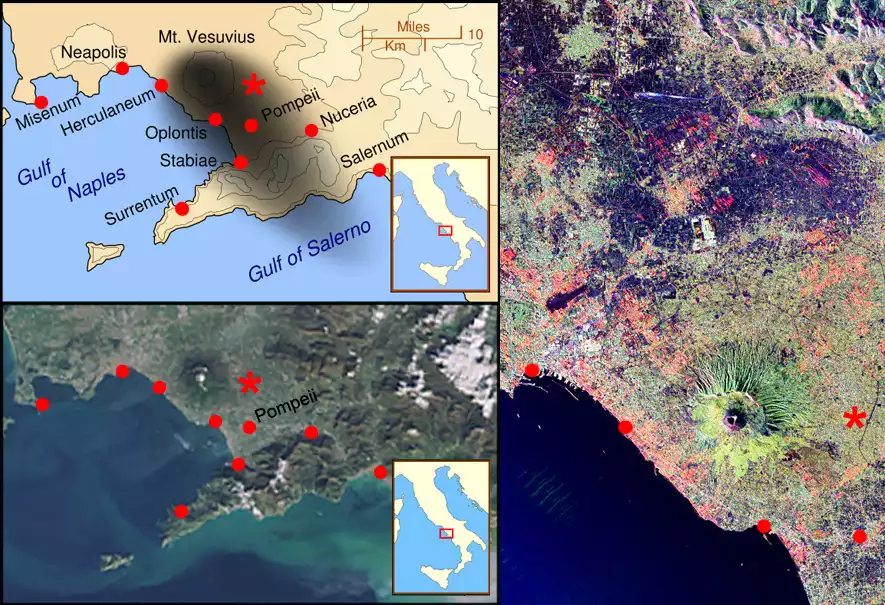
Upper left: The map on top shows the area around Mount Vesuvius and some of the historically important cities including Naples (Neapolis), Herculaneum (Ercolano), and Pompeii. The dark shaded area depicts the approximate region affected by the eruption of 79 AD.
Lower left: A NASA satellite image of the same area with the cities indicated by the red dots.
Right: A NASA radar space image shows the features of the volcano and its crater more clearly. The 340th Bomb Group just happened to be stationed at Pompeii Airfield near Terzigno, Italy just a few kilometers from the foot of Mount Vesuvius (see red asterisks on maps above) when the volcano's last major eruption occurred between March 18-23, 1944.
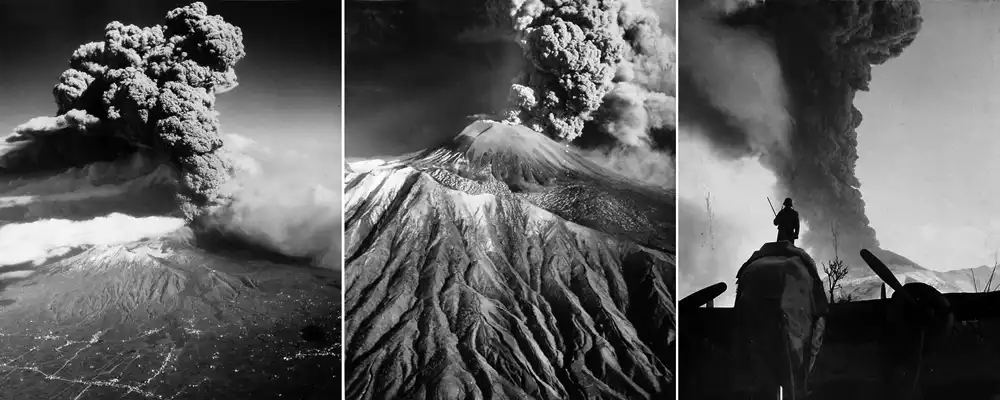
Three different perspectives of Mount Vesuvius erupting in March of 1944 (photos from NARA in College Park, MD).
The volcano destroyed more of the 340th Bombardment Group's aircraft (estimates vary between 78 and 88) than the devastating German Luftwaffe air raid of the 340th base at Alesani, Corsica on May 13, 1944 (about 75 aircraft). At Pompeii Airfield on March 23, 1944 nearly all of the 340th's B-25 Mitchell medium bombers were covered with hot ash that burned the fabric control surfaces, glazed, melted, or cracked the Plexiglass, and even tipped some B-25s onto their tails from the weight of the ash and tephra.
No lives were lost at Pompeii Airfield and the only casualties in the 340th were a sprained wrist and a few cuts, but the effects of the volcano on the aircraft proved insurmountable despite a major effort by the 12th Air Force to repair and salvage the damaged planes.
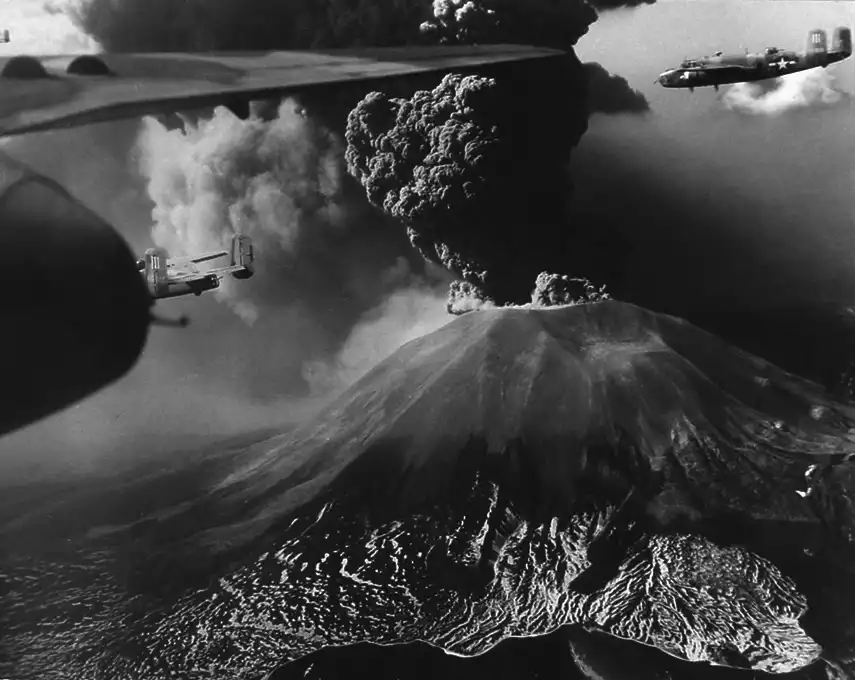
These B-25s from the 447th Squadron of the 321st Bombardment Group passed very near the erupting volcano on their way to bomb targets. Here's the way P-39 Airacobra fighter pilot Joseph P. Gomer of the 301st fighter squadron/ 332nd fighter group, described the volcano after leaving his base at Salerno, Italy: “I remember taking off that day and swinging over the coast. I could see all that red lava just flowing down. A beautiful sight.”
Dana Craig from the 486th Bombardment Squadron of the 340th Bombardment Group experienced the eruption of Mount Vesuvius first-hand:
"...On the day prior, Vesuvius was belching smoke. It was an overcast sky with the threat of rain. About midnight, I went out of my billet to answer the call of nature. While outside, in a mild drizzle, I was hit on the head by what I thought was a small rock. Suspecting some sort of joke, I went inside for a flashlight. When I returned, the light revealed a layer of damp cinders on the ground. We knew at that time that Vesuvius was erupting. We began to feel the earth shake as though a bomb had gone off. After each quake, a few minutes would pass before the debris blown out of the crater would start to hit the ground. About daylight, the rear of our building started to cave in. We then began to see the larger rocks coming down. By this time everyone was wearing his steel helmet and heavy sheepskin jacket for protection from the falling material. I can't recall ever having breakfast that morning. It wasn't very long before we were loaded into trucks and evacuated to Naples."
According to the excellent detailed account of the 1944 Mount Vesuvius eruption in the 489th Bomb Squadron Book, the 340th Bomb Group decided on March 22nd to evacuate the Pompeii Airfield because of the possibility of increased volcanic activity and the threat of dangerous lava flows approaching from the slopes of the mountain. Approximately one foot of ash covered the ground.
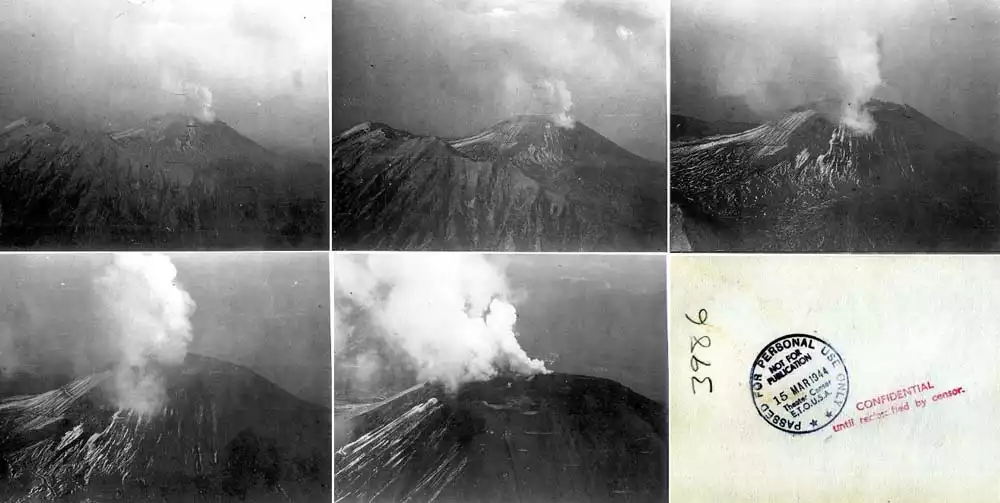
The five photographs of Mount Vesuvius above were purchased at a flea market in Tulsa, Oklahoma by geologist Paul Roales and kindly shared for this website. Each photo was apparently taken on March 15, 1944 and marked on the back as shown in the lower righthand panel. The photographer was likely in an aircraft of the USAAF. The pictures provide a glimpse of the volcano just a few days before its last major eruption.
Dr. Leander K. Powers served in Italy during World War II and his diary provides an interesting chronology of the March 1944 eruption:
Saturday, March 17, 1944
"While we were just finishing supper, someone called to say there were huge red streams of lava flowing down the sides of Mount Vesuvius. It was a sight to behold. Never had we seen such at night — usually a faint red glow at the most. As we watched the streams, like giant fingers flowing down the sides, we could see a glow in the sky. All during the night and Sunday there were quakes of the earth with tremendous roars - similar to thunder - from Vesuvius. The windows rattled, and the entire building vibrated."
Sunday, March 18, 1944
“On Sunday night, the roars became more frequent and grumbled like a lion’s roar. Streams of fire were shooting thousands of feet into the air, and the countryside was lit up for miles around. Oft times the entire top of the mountain looked as if it were a blazing inferno. It’s really uncanny, yet amazing to look at this phenomenon. The vibrations of the building were truly uncomfortable.”
Monday, March 19, 1944
"I learned that a stream of lava was flowing down the side toward Naples, so we rode over to see it. It was the most phenomenal thing I have ever witnessed. A huge mass of fiery coals some 20 feet high and 200 yards wide destroying everything in its path. There were many people evacuating their homes, which we saw destroyed as the lava pressed on. At night, the sky and countryside was bright for miles around. Flames were shooting into the sky for thousands of feet."
Tuesday, March 20, 1944
"Tuesday night, the entire town vibrated, and there was a roar almost unexplainable. Lava rocks could be seen all over the mountainside."
Wednesday, March 21, 1944
"Wednesday morning, we could see smoke boiling from the crater for miles into the sky. This continued all the afternoon. We heard that the road to Salerno was covered with cinders and traffic was greatly impeded."
Thursday, March 22, 1944
"Thursday morning, we rode down beyond Pompeii. The cinders were so deep that traffic was stopped. Along about noon, the wind changed and the cinders began falling on Torre Annunziato. Everything had a coat of black, just like light snow. We rode up toward the Naples side on the Autostrade, and, as the wind was blowing toward town, I got a wonderful view of the boiling inferno. Yesterday, I rode into the town that was destroyed by the flowing lava and apparently the flow was coming to a stop, but the devastation was terrific. Tonight there is a lot of lightning coming from the crater and infrequent blasts. I learned from an Allied Military Government officer that 78 planes (B-25) were destroyed on the Pompeii airfield during the past few days by the lava and cinders."
Friday, March 30, 1944
"The eruption seems to have abated very slowly during the past few days. Cinders and ashes have been raining down over all the villages in this section, but seem to be slowing up. The smoke from the crater is apparently changing from the intense black to white again. Yesterday, I looked at the Autostrade through my glasses, and it is apparently covered with cinders as is the entire mountainside. Only two weeks ago, I rode up the Autostrade and then walked several hundred yards up toward the crater. Yesterday afternoon, we rode in the ambulance, and, on the way back, we took a shortcut via Pompeii. Bulldozers were plowing the cinders to the side of the road in huge banks. Practically all the gardens and vineyards are covered to a tremendous depth in the area all the way from Vesuvius to Salerno. Many people are homeless and without food, but they seem to take it in stride, just as the Northerners take the snow in winter. After this eruption it’s easy to visualize the destruction of Pompeii - a most amazing and uncanny phenomenon. From my quarters I can still see what appears to be small areas with smoking lava, but the smoke from the crater has abated. Today, the wind is blowing inland, and it appears that cone is much lower than before. Vesuvius is definitely not dead after all these years of inactivity.”
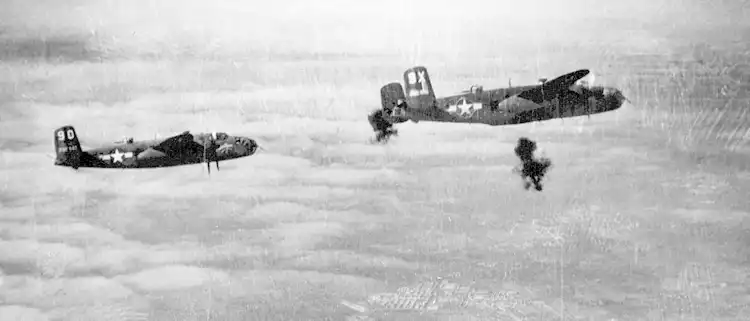
Here are two planes from the 489th bombardment squadron getting peppered with flak on a mission. That's B-25D Stardust 9D on the left but this isn't the same 9D that my father, Quentin Kaiser, flew two missions in. Note that the top turret on the B-25D model was positioned much further back than the top turret on the B-25J model. There were actually four different 9Ds. The first 9D (serial# 42-53479) was lost at sea on 9-9-43 after 40 missions. The second 9D (serial# 42-32447), Stardust (above), was destroyed on 3-22-44 by the eruption of Mount Vesuvius after 78 missions. The third 9D (serial# 43-32504) was damaged during the German air raid at Alesan Air Field, Corsica on 5-13-44 after 23 missions and sent back to the states. The fourth and final 9D (serial# 43-27638), Briefing Time, flew 126 missions from Alesani, Corsica until the end of the war. This last 9D was the plane my father flew 2 missions in. Photograph from Dominique Taddei.
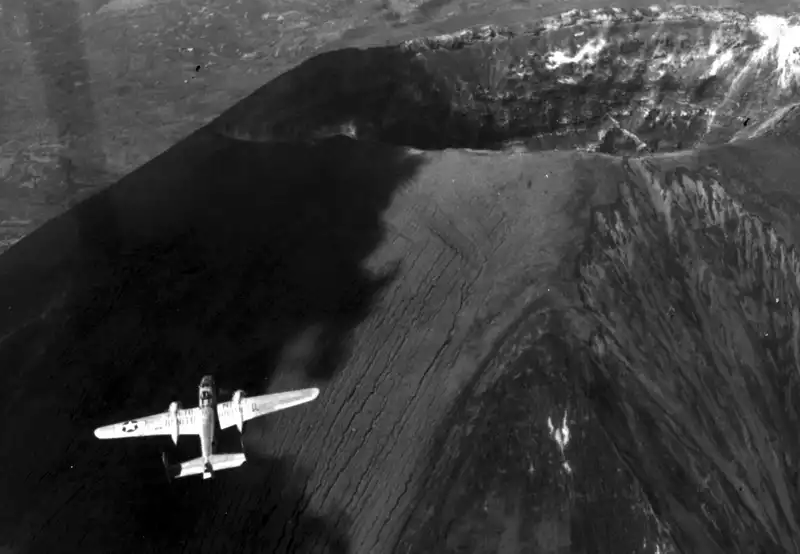
This amazing photo comes from Dominique Taddei who got it from John Sutay, former 57th Bomb Wing Historian, who passed away on May 31, 2002. In Corsica, John Sutay was a radio ground operator in the 340th BG, 486th BS. The photo was taken above Mount Vesuvius in May 1945. The B-25J pictured, "Finito Benito Next Hirohito," was neither assigned to a BG nor flew combat missions but was based at Naples with the 12th Air Force around the end of the war.
See the account of the Mount Vesuvius eruption from the 489th Bomb Squadron Book.
Film footage of the 1944 Vesuvius eruption on YouTube.